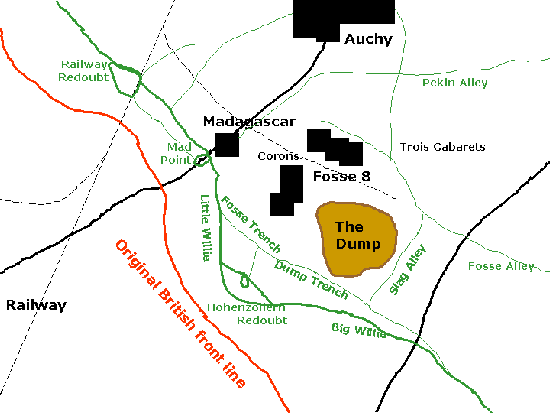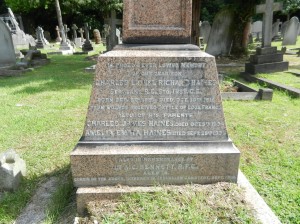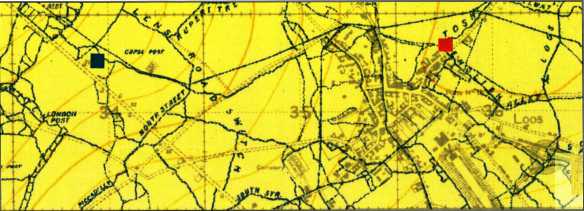Lionel Lush Phipps’ birth was registered in the second quarter of 1896, and he was baptised on 16 May 1896 at Hardingstone in Northamptonshire.
His father, Albert Edward Phipps was a solicitor, and his mother was variously recorded as Marie Quita; Mari Zuita (on Lionel’s baptism record); both Margarita and Mariquita (on her marriage transcriptions); and Mariquita (on Lionel’s CWGC record)! Their marriage was registered in Portsea in Q2, 1890 and they lived in Hardingstone.
At the end of March 1901, aged 5, Lionel and his mother were staying with his aunts, Emma and Amy Lush, at the home of his grandfather, Joseph Lush at Ryde on the Isle of Wight. Later, Lionel attended Repton School in Derbyshire, and was enumerated there, aged 15, in the 1911 census.
He would probably have been a member of the school cadet training force, and he joined the army ‘straight from school’. He was commissioned soon afterwards into the 7th Battalion of his local Northamptonshire Regiment as a
Temporary Second Lieutenant with effect from 22 September 1914.[1] His younger brother was in the same Regiment.

After his death, a photograph appeared in the local paper.[2]
The 7th (Service) Battalion was formed at Northampton in September 1914 as part of K3 and came under command of the 73rd Brigade in the 24th Division. They moved to the South Downs and into billets in Southwick between November 1914 and April 1915, and then on to Woking in June 1915. On 2 September 1915 they landed at Boulogne.[3]
This agrees with Lionel’s Medal Card which recorded that he went to France on 2 September 1915.
There is fairly good information on their movements in the Diaries and reported on the Web.[4]
The 7th Battalion was part of 24th Division and had only just arrived in France when it was allocated as Reserve for the offensive at Loos on 25th September.
Already tired from the forced march, though only five men fell out, they were held back too far from the Front line (a decision that was instrumental in Sir John French losing his job) and did not arrive in the line until late on the 25th. Being relatively “unscathed” by the forced marches of the previous days, the 7th Northamptonshires were sent up to the battle before the rest of the division on the evening of the 25th rather than on the 26th like much of the rest of the division.
They were given no instructions at all on reaching the front line and instead they were just told to follow an officer of the 9th Division up to relieve one of the assaulting battalions. Led by ‘C’ Company the battalion crossed the battlefield in full kit negotiating seven trenches before they reached the battalion they were to relieve. They formed a defensive flank between the Hohenzollern Redoubt and Fosse 8 which they held overnight. On the 26th they were then hit by a German counter-attack against ‘B’ Company trenches which were bombed, but the attack was repulsed. Lt. Morley of B Company would have been recommended for the VC that day, but both he and his senior officer, Colonel Parkin, who had intended to recommend him, were killed. On one occasion the battalion received instructions to retire and had withdrawn most of the way back to their lines before being sent back across 600 yards of ground to take up their positions back in the front line.
On Monday 27th September 1915, ‘C’ and ‘D’ Companies near Fosse 8 were attacked from the rear by Germans using bombs. Captain Mansfield collected a mixed force of men and counter-attacked to relieve ‘C’ Company. A further counter-attack to regain the village at Fosse was cancelled after several senior officers, including General Thesiger were killed by a shell whilst organising the attack.
The battalion held their positions for the rest of the day before being relieved on the evening of the 27th.
A more detailed account in the war diary noted:
27 September 1915: Auchy area: The men of 73rd Brigade holding the positions east of Fosse 8 are in an exhausted condition, having no food, water or sleep for 48 hours.
12.00 noon: Heavy enemy shelling of Fosse 8 and tracks to the North (Trois Cabarets) begins and continues all afternoon and evening.
Heavy enemy shelling of Fosse 8, tracks to the North (Trois Cabarets) and communication trenches leading up to the Hohenzollern Redoubt continues throughout the night.
2.30am: An attack against Fosse 8 by the 1/Royal Berkshires, detached from Carter’s Force, is halted 70 yards from their objective, after crossing half a moonlit mile under fire.
Dawn: German infantry attacks 21st Brigade in Stone Alley, adjacent to Vermelles-Hulluch road, but is beaten off by 2/Wiltshires. Shortly afterwards, an enemy attack in battalion strength hits 73rd Brigade in Fosse and Slag Alleys. (The men of this Brigade holding the positions east of Fosse 8 are in an exhausted condition, having had no food, water or sleep for 48 hours.)
7th Northamptonshires are forced back to cottages at Corons de Pekin, North of the Fosse 8 Dump [a slag heap from a coal mine]. The enemy places a heavy machine-gun on the slopes of the Dump, and brings the area between the Dump and the Hohenzollern Redoubt under fire.
Note: the heaps alongside them [the pits] are called Fosses. Most important areas included the dump at Fosse 8, in front of Auchy, and the Quarries in front of Hulluch. Both positions were strongly fortified by the enemy, the one at Fosse 8 being called the Hohenzollern Redoubt.

Attack on Fosse: 28 September 1915: 9.30am: 85th Brigade of 28th Division, supported by 83rd Brigade, attacked at the Dump and Fosse 8. Many casualties were suffered by both sides in desperate fighting in the confined trenches around the Hohenzollern Redoubt. At around 4.00pm, 2nd Guards Brigade attacks Puits 14 bis, but after suffering very heavy casualties from machine-guns firing from in front of Bois Hugo they are ordered to halt.
There were heavy losses – Battalions at the time had some 650-750 men: the 7th Northamptonshires lost 377, of which 11 officers, including their Lt. Col. A. Parkin, in the attacks around Fosse 8.
For more information go to ‘Battle of Loos’ on Rugby Remembers or for a more detailed report on the Battle of Loos, go to: http://www.1914-1918.net/bat13.htm.
Overall in the Battle of Loos, more than 61,000 British casualties were sustained: 50,000 in the main fighting area between Loos and Givenchy and the remainder in the subsidiary attacks. Of these, 7,766 men died.
A more specific mention of Lionel Phipps is given in a later history of the Battalion.[5]
The casualties had been heavy in numbers, but numbers alone do not represent the seriousness of the loss to the battalion. … Captain V. D. Shortt, Lieutenant L. L. Phipps, both of whom had already been wounded earlier in the battle, were killed; … What the battalion owed to these officers cannot be expressed in words, but those who served under them or with them cannot hear the Battle of Loos mentioned without recalling their characters to memory with love and pride. … The casualties amounted to 402 all ranks, and included very many of the best of the battalion, and it was not long before rumour reached Northampton that the battalion had been ‘wiped out’, … the Battle of Loos in 1915 from its very newness to all ranks, was the severest trial that the 7th Northamptonshire Regiment was called on to face during four years’ constant fighting in France and Flanders.
Temporary Lieutenant Lionel Lush Phipps, was just one of the 402 who were wounded and died at and around Loos on 28 September 1915. He had been in France and Belgium for a mere four weeks.
He is buried at the Noeux-Les-Mines Communal Cemetery, in plot I. K. 12., and is remembered also on the Rugby Memorial Gates.
He was awarded the British and Victory Medals and the 1914-15 Star. His file is available at The National Archives at Reference: WO 339/14355.
In fact the date of Lionel’s death was never entirely clear. The memorial notice inserted in the local newspaper read ‘Phipps, killed in action in France, on 26th or 27th September … younger son …’.[6] A notice elsewhere in the same newspaper confirmed that he was ‘… educated at Repton and joined the 7th Northamptonshire regiment on leaving school. He was a very popular young officer and an all-round sportsman. His father is a Captain in the National Reserve, and his brother Ronald was recently wounded in the foot whilst serving in France.’
Whilst Lionel is remembered in Rugby, as yet, no connection with the town has been found!
As noted above, his older brother, Lieutenant Roland H. Phipps, was also a Lieutenant in the Northamptonshires and had been wounded in the foot, a few months earlier.[7] He survived the war and died in 1964, aged 66.
RUGBY REMEMBERS HIM
[1] The London Gazette, 22 September 1914, Issue:28910, Page:7488.
[2] Northampton Mercury, Friday, 8 October 1915.
[3] http://www.1914-1918.net/northants.htm
[4] http://1914-1918.invisionzone.com/forums/index.php?showtopic=49720
[5] H. B. King, M.C., 7th (S.) Battalion, Northamptonshire Regiment, 1914-1919, Gale & Polden, Ltd., 1919.
[6] Northampton Mercury, Friday, 8 October 1915.
[7] Northampton Mercury, Friday, 6 August 1915.







